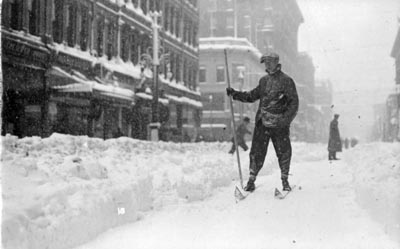Colorado has witnessed its fair share of intense winter weather. The state’s history is peppered with legendary snowstorms and blizzards that have left an indelible mark on the memories of its residents. These memories are documented in firsthand accounts of blizzards and snowstorms that can be found in resources like The Colorado Magazine (formerly Heritage Colorado), the Colorado Encyclopedia, and in newspaper articles found in the Colorado Historic Newspapers Collection.

The Great Die Up, Winter 1886-87
Only a few years after official weather records began being kept for Colorado, the state experienced the harsh winter of 1886-87 that was later nicknamed “The Great Die Up.” According to a Colorado Encyclopedia entry, this winter started early on the Front Range and eastern plains with a blizzard in mid-November, and the cold weather and snow continued through March. During this time, a large portion of the plains were considered “open range,” meaning that cattle herds could freely graze on the land. During this winter, the cold weather and snow cover made grazing almost impossible, and cattle were routinely lost in the blizzards. It’s estimated that nearly a quarter of the cattle in the Front Range died. This catastrophic loss, along with the environmental degradation caused by massive cattle drives and land privatization, led to the end of open range grazing in Colorado.
1899
The winter of 1899 was known as “the winter of deep snow” by the people living in Kokomo, which at the time was a thriving silver- and gold-mining community in Summit County. The January 1963 edition of The Colorado Magazine reprinted a letter that a high school teacher in Kokomo, Mattie Walker Neves, wrote to her sister-in-law about the snowstorm. She writes that the winter began normally for a high mountain town, until January when, “the snow fell and the wind blew continually,” cutting Kokomo off from the rest of Colorado. Neves writes about the voracious reading of the townspeople that winter, trading books so everyone had new material to read, and the excitement caused by the arrival of the one weekly newspaper that was fetched on foot from Leadville. Another form of entertainment was playing cards, although she assures her sister-in-law that they didn’t gamble. Trains with fuel, food, and other supplies finally reached Kokomo at the end of April and life resumed as normal.
1913
More than 110 years later, the 1913 blizzard is still considered to be Colorado’s worst blizzard. The storm took place from December 1-5, ending in a total of nearly 46 inches of snow in Denver, and even more in the foothills and mountains of the Front Range. The article “Colorado is Snowbound — the Great Front Range Blizzard of 1913 (and its 2003 Counterpart)” in the Autumn 2003 issue of Colorado Heritage shares stories about the blizzard, focusing on Denver and Georgetown. The article includes information about the developing science of daily weather forecasting, which was in its infancy in the early 1900s. Some newspaper forecasts for the first day of blizzard called for partly-cloudy skies, meaning that many people were unaware that a snowstorm was on its way.
Also included in the article are letters and diary entries from people who experienced the storm firsthand, telling tales of creative travel methods in the snow and of the inventive cooking that was necessary until groceries could be delivered again.
The article ends with a comparison to the March 2003 blizzard, which is considered to be the second-worst storm in Colorado’s history (although the measured snow totals were fell far short of those in 1913).
1921
In April 1921, a powerful winter storm swept across Colorado, dumping snow on the central mountains. According to the Colorado Climate Center, 76 inches (over 6 feet!) of snow fell from April 14-15 in Silver Lake, which still stands as a nationwide record for the most snowfall in 24 hours.
The snow took some Coloradans by surprise – newspapers from the time reported on three people who left Kersey to drive to Dolores on April 13 and were believed to have gotten lost in the mountains during the blizzard. Luckily, the April 26th edition of the Colorado Daily Chieftain reported that the trio were found safe and sound after they were, “forced to abandon their car at a small town enroutte to Dolores and seek shelter from the storm.” An editorial published in this same newspaper a few days before the travelers were found admonished newcomers for attempting to drive through the mountains in April at all, warning them that heavy snowfall shouldn’t come as a surprise in the spring.
1946
In early November 1946, the Front Range and eastern plains were hit with a long-lasting snowstorm that left 30 inches of snow after 70 hours. Golden residents and Colorado School of Mines residents were particularly affected by this storm because it led to the cancellation of a slate of homecoming festivities, including the homecoming football game. However, The Colorado Transcript reported that the homecoming dance went on as planned, with only, “a few couples braving the elements to attend.” Not everything was cancelled in Golden – newspaper delivery boys maintained their routes, ensuring that everyone stayed updated on the impact of the storm. The boys’ exemplary work earned them a special invitation to attend a Mines football game later in November with the postmaster.
- Celebrating Colorado’s immigrant heritage - June 27, 2025
- Colorado’s Scenic and Historic Byways: Guanella Pass - June 6, 2025
- Who is protecting Colorado’s pollinators? - May 16, 2025